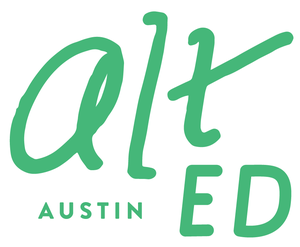Making a very different Romeo & Juliet
/Brian Oglesby (also known as the award-winning playwright Briandaniel Oglesby) teaches theater arts at Skybridge Academy in Dripping Springs, Texas. We invited him to share with our readers his unusually collaborative process of writing and producing a new version of Shakespeare’s Romeo and Juliet—one that speaks from and to the hearts of his young students.
In late May, a group of junior high students will perform an LGBT adaptation of Romeo and Juliet at Skybridge Academy. Romeo and Juliet are a same-sex couple. The students helped make this little play, and they are proud of it.
The existence of a rainbow-flavored imagining of the bard’s work isn’t revolutionary. The age of the students, and that this is in a school in Texas, and that the students chose this project—that’s what breaks new ground.
Broken ground will eventually become a familiar path; in a few years, preteens telling these stories will be normal. In the meantime, I marvel at the fact that this is happening.
Two years ago, Skybridge hired me to teach theater after I graduated from UT’s Playwriting program. I didn’t want to simply produce the same old Our Town or Guys and Dolls; those plays don’t speak to the current condition, and besides, I’m a writer, not a director. I wanted to contour the plays to my students, to make something from and for them. And Skybridge’s emphasis on teacher-student collaboration made new work a natural fit.
I use improv-based activities and devising techniques to generate material that I fashion into text so the students become part of the fabric of the plays. We find the space where my skills and interests as an artist collide with their skills, interests, and potential. The students take ownership of the play and, I hope, realize that they can make work of their own.
Early this semester, the junior high students generated a number of story ideas, and one stood out: a king with a rebellious daughter in love with another princess. Energy began to coalesce around this.
The students also responded to adaptations of classics. When I suggested Romeo and Juliet (which offers a robust plot and multiple protagonists), one of my students piped up that we should make Romeo and Juliet a same-sex couple, taking the conflict they’d created and mixing it into the old text.
The students voted anonymously, and the clear victor was this adaptation.
We set to work. Improv-based activities brought about irreverent ideas, like turning Friar Lawrence into a Fryer—a guy who operates a fry shack—and Paris into, well, a Paris Hilton-like figure. Dozens of their lines, including a translation of the pilgrim sonnet, made it into the script.
And we got to talking. We talked about heavy issues like gay teen suicide and LGBTQ history. Some of the students can’t invite grandparents to the production, demonstrating the generation gap. This gap is a tension in the play itself, as Juliet’s father wants him to marry a woman. We talked about how few stories exist for young LGBTQ people. We talked about how what we’re doing just isn’t done.
Two years ago, a project like this would have scared the hell out of me. Heck, in December this project would have scared the hell out of me. I’d be afraid of being accused of promoting the “Gay Agenda.” If the students hadn’t suggested this project, it wouldn’t exist.
Part of this is Skybridge. The students know that our school is a safe place for LGBT people. We all make sure we’re using correct pronouns. I’m out and proud, as are a number of their classmates, and I teach an LGBTQ+ Stories class.
Part of this is generational. There is no “new normal” to the current crop of young folks; there is normal and there’s the “old normal.” Same-sex couples are being crowned prom kings and queens, and more than 50 percent of the upcoming generation recognizes that gender isn’t binary. And when you co-create with young people, the work reflects this reality.
Young people will replace us. Some of their values will change as they get older; and some of their values will change the world when they get older. This reality will find its way into the mainstream, and there will be more LGBTQ stories about, by, and for young people.
And the students have a sense of this. They are proud to be a part of it.
In two weeks, this will be similar to every single junior high play the audience has seen before. Someone may forget a line, of course, and our lighting will be clip lights, and it’s set outdoors. But I can also guarantee that this will be unlike anything they’ve ever seen.
Unless it rains.
Brian “Briandaniel” Oglesby
[You and your family and friends can experience this special production yourselves on May 20 or 21. Learn more here.]



























